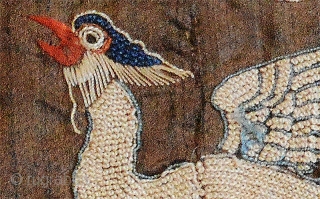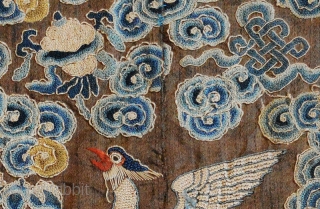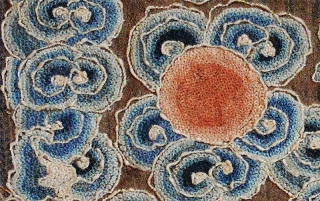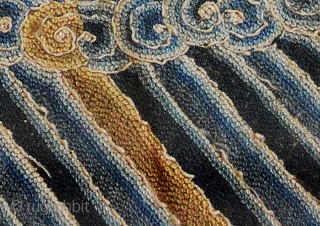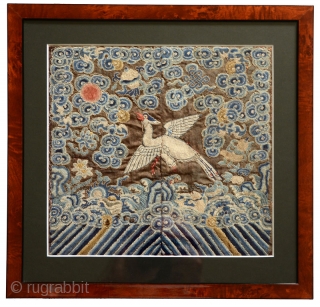Back
Chinese Civil Rank Buzi (pu zi) or ‘insignia badge’ (also often referred to as ‘Mandarin Squares’), hand woven in silk - the design-features using the tiny ‘Peking Knot’ - from the late Qing / aka Ch’ing Dynasty, denoting a Civil Rank Official of the 9th Level (various elements of this Buzi point to it coming from the mid 19th century, most likely the decade of the 1850’s). There were nine ‘levels’ in both civil and military ranks and the specific bird or animal depicted in the badge indicated the wearer’s rank (various birds species were used exclusively for civil ranks, while various animal species were used exclusively for the military ranks). Here we have depicted a Paradise Flycatcher - as can be discerned by the spots or ‘eyes’ on the two centre tail feathers, and hence the bird which is the designation for a 9th Rank Civil Official - gazing upwards at the sun disc. a mixture of Chinese symbols have been incorporated into the background design of this badge, both in the frothing waves and the clouds of the main field. Although these symbols consist primarily of most of the Buddhist Eight Precious Things, a symbol or two from both Confucianism and Taoism have also been inserted, the wearer obviously seeking all the good fortune he could attract to himself. Buzi’s were generally made in pairs, one for the back and one for the front of a robe, and as robes opened down the centre front, the badge for the front of the robe will always be split into two halves vertically (as can be discerned here) to accommodate the centre opening of the robe. This badge, with the split down the centre separating the two ‘sides’ is therefore from the front of a robe. ----------- Paradoxically it is the lower rank badges that are scarcer and less seen on the market, as the upper ranks had more money and the need for more robes, and hence the ‘proliferation’ of the higher ranked badges. Besides, about 75% of all Mandarins were in the upper five ranks, hence the greater likely-hood of finding a higher rank badge. On the other hand the lower ranks, being much poorer, and with less opportunity for advancement, often only had one robe with a Buzi on, and as tradition decreed, were buried in their finest garments, which was often a Buzi clad robe. Hence the lower rank badges are not as often seen on the market. ----------- Professionally mounted and preserved behind glass in a beautiful burl-wood veneered frame, the size of the Buzi itself is 28cm wide x 27cm high / with the frame 37.5cm wide x 36.5cm high (approximately 11in x 10.5in / with the frame 14.75in x 14.25in).
price:
Price on request
- Home
- Antique Rugs by Region
- Category
- Profiles
- Post Items Free
- Albums
- Benaki Museum of Islamic Art
- Budapest: Ottoman Carpets
- Gulbenkian Museum
- Islamic Carpets. Brooklyn
- Islamic Textiles. Brooklyn
- Konya Museum: Rugs
- MKG, Hamburg
- MMA: Caucasian Carpets
- MMA: Mamluk Carpets
- MMA: Mughal Indian Carpets
- MMA: Ottoman Carpets
- MMA: Safavid Persian Carpets
- MMA: Turkmen Rugs
- McCoy Jones Kilims
- Ottoman textiles. Met
- Philadelphia Museum
- Rugs and Carpets: Berlin
- Seljuqs at the Met
- TIEM, Istanbul: Carpets
- V&A: Classical Carpets
- Vakiflar Carpets: Istanbul
- Baluch Rugs: Indianapolis
- Gallery Exhibitions
- Jaf an Exhibition
- Alberto Levi Gallery
- Andean Textile
- Christie's London: 2016
- Francesca Galloway
- HALI at 40
- ICOC Washington, DC 2018
- Jajims of the Shahsavan
- London Islamic Week April, 2018
- Mongolian Felts
- Navajo Rugs: JB Moore
- Persian Piled Weavings
- SF Tribal & Textile Art Show 2020
- SF Tribal 2019
- Sotheby's: C. Alexander
- Turkish Prayer Rugs
- Turkmen Main Carpets ICOC 2007












